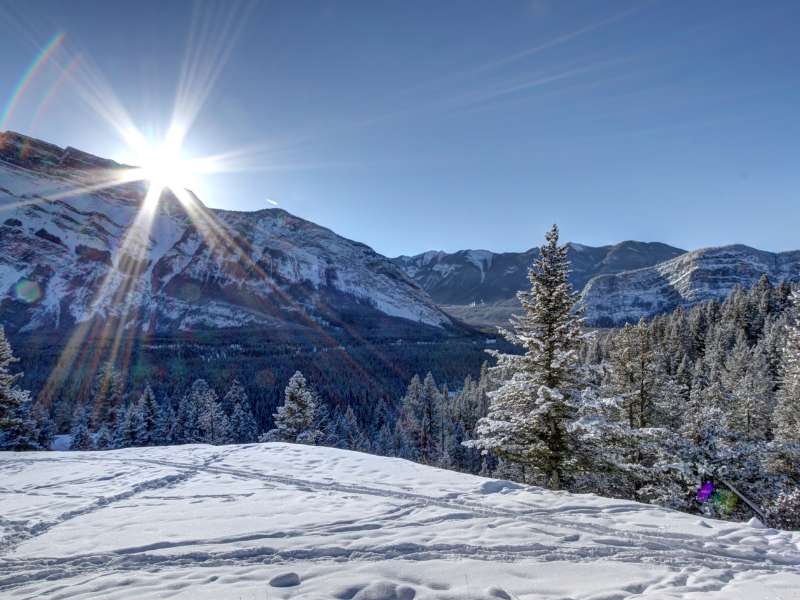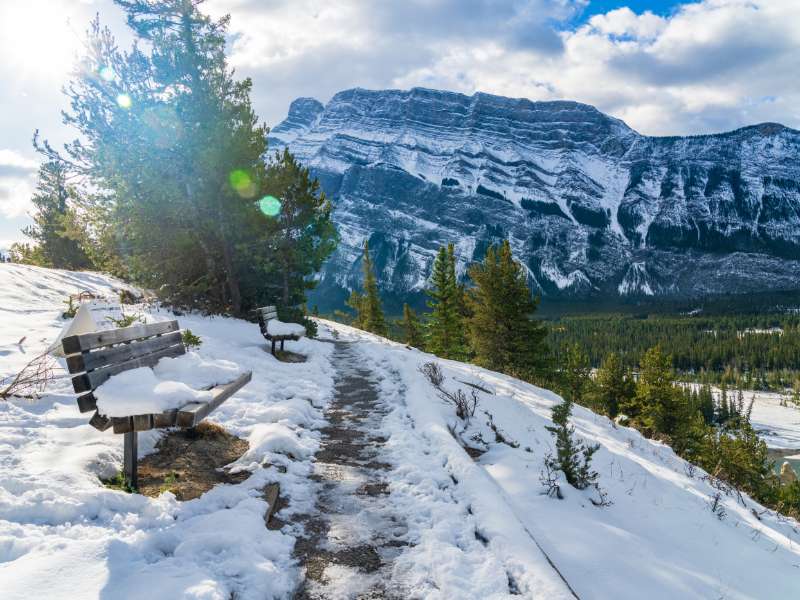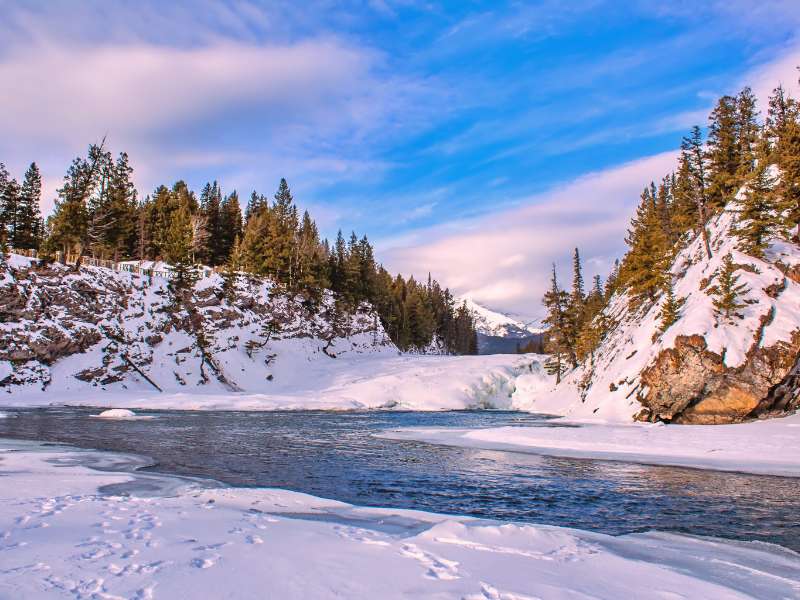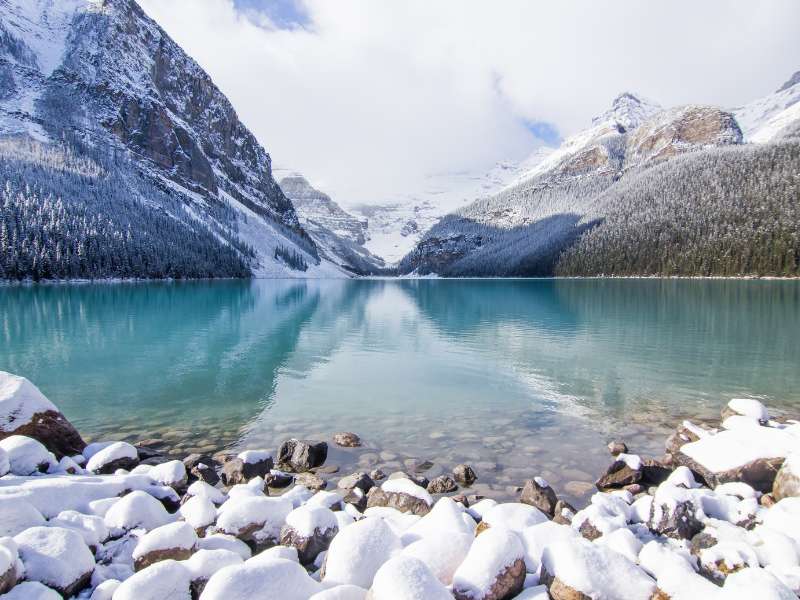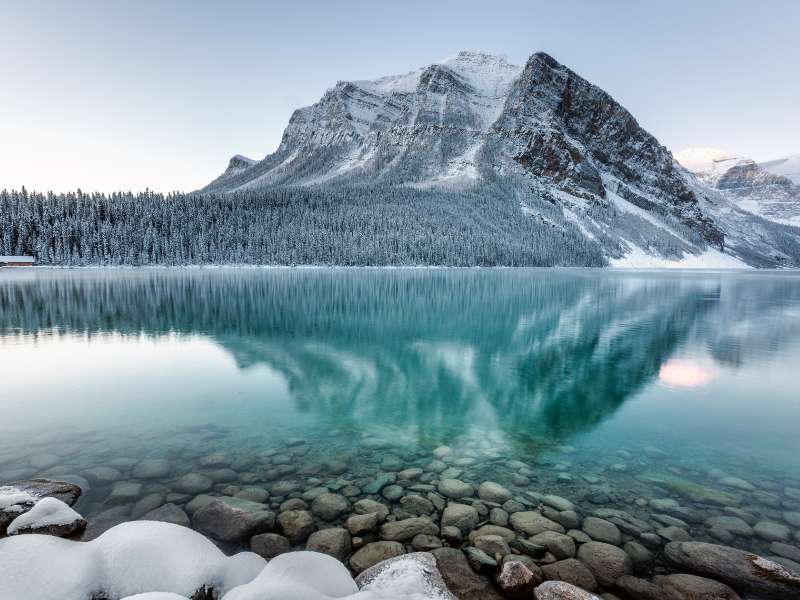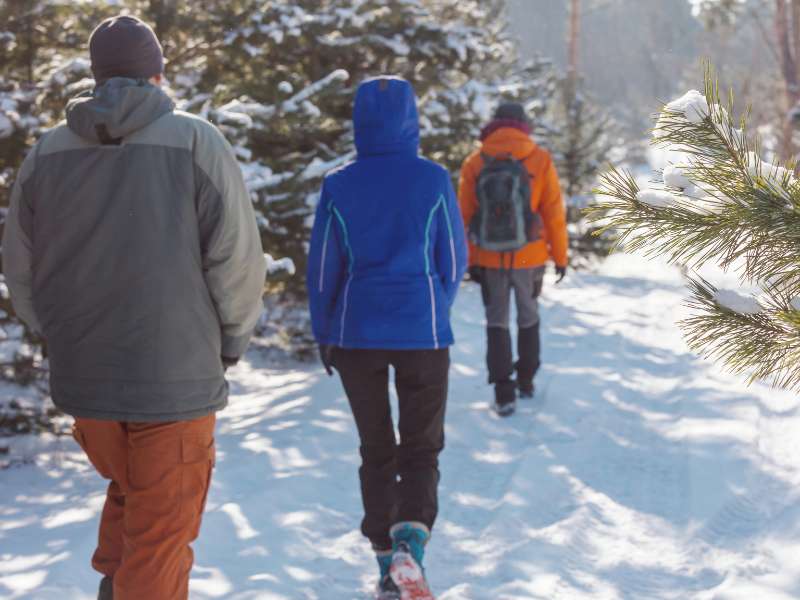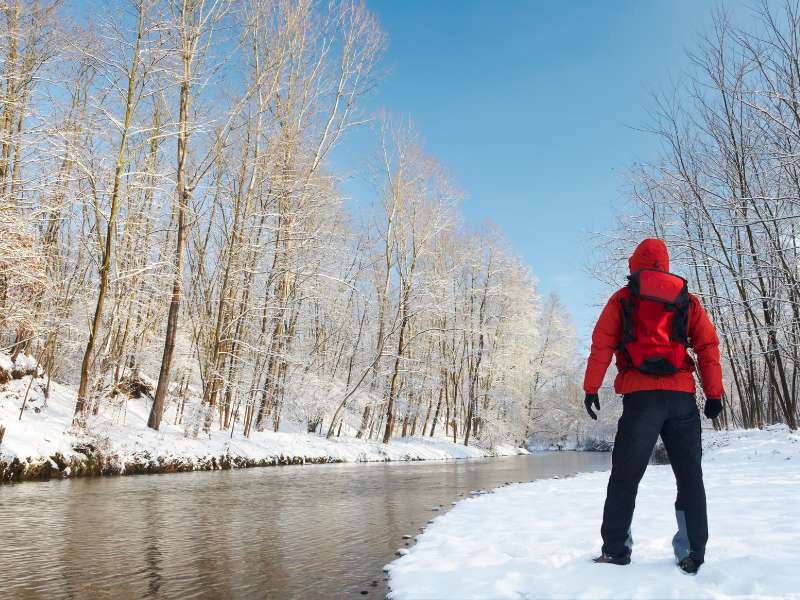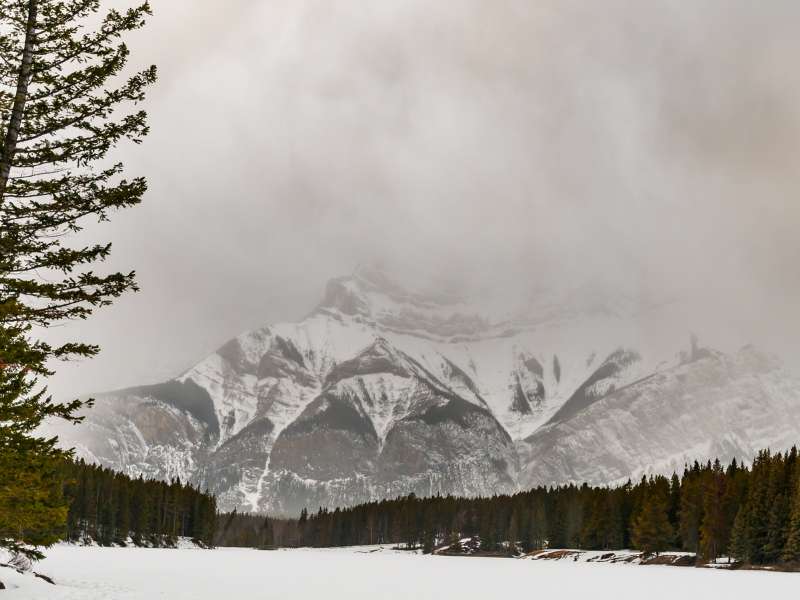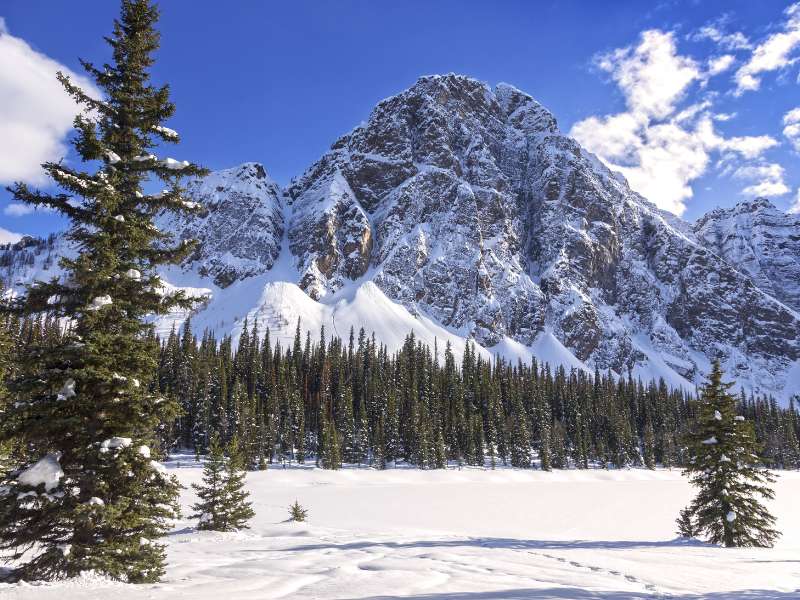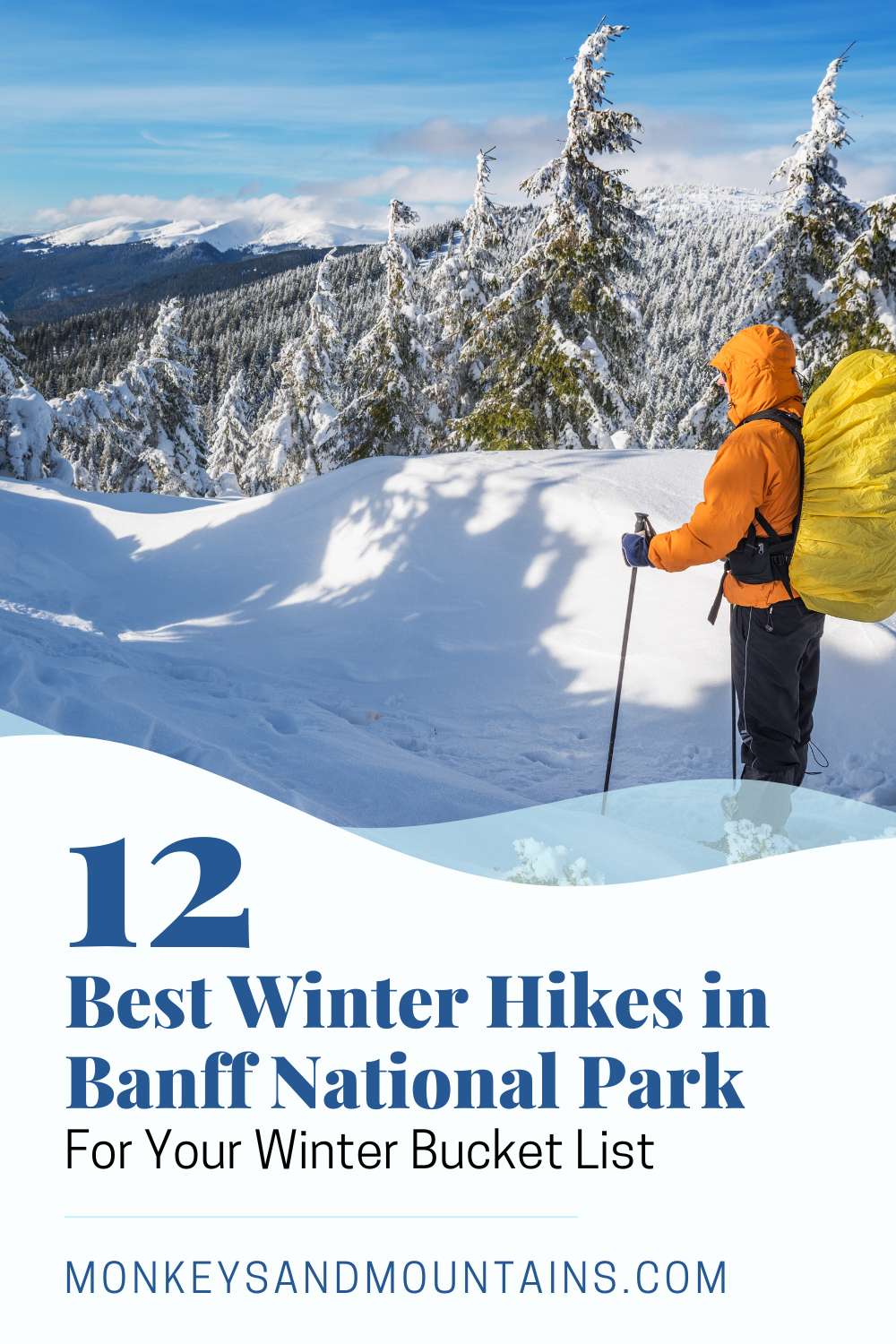The most beautiful winter hikes in Banff will take your breath away. While Banff is famous for its summer hiking, hiking is also a popular winter activity with snow-capped peaks is majestical. Not to mention that you’ll avoid the crowds.
Table of Contents
As someone who’s done winter hikes in Banff for over 12 years, I can tell you it’s such a gorgeous time of year to hike or snowshoe. While many people think hiking is limited to summer, I actually think the scenery and snow-capped mountains are even more beautiful in winter.
Plus, I love seeing all the animal tracks and trying to identify them, from squirrel footprints to deer or even wolves if you get lucky. Check out the best places to see wildlife in Banff here.
I understand that hiking in winter can be intimidating, and you may be worried about avalanches, so I’ve compiled the best winter hikes in Banff.
Go on one of these hikes and trust me, you’ll want to keep checking more off our bucket list. They’re absolutely stunning! Just be sure you have the right winter hiking gear.
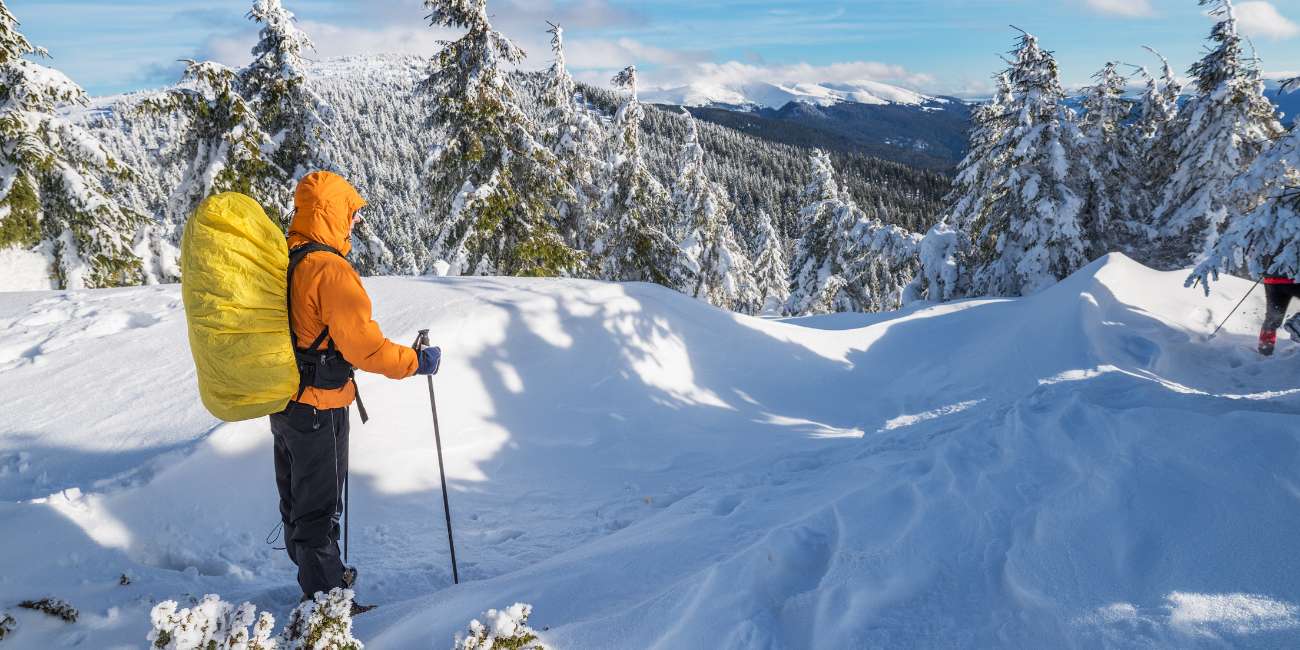
The #1 Top Winter Hike in Banff
If you only do one winter trail in Banff, let it be the Johnston Canyon Icewalk.
Hike to Johnston Canyon Lower Falls
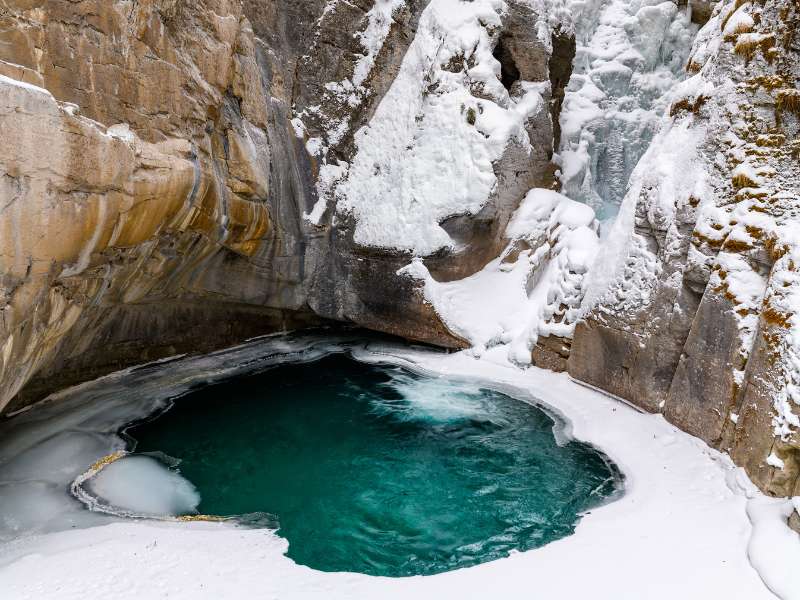
Johnston Canyon Trail to Lower Falls, also known as the Johnston Canyon Icewalk in winter, is one of the busiest but most beautiful trails in Banff, especially in winter. The trail is on a boardwalk, making it accessible for the whole family.
The highlight is the breathtaking frozen waterfalls and the huge icicles that cling to the sides of the canyon. I do this hike along the Bow Valley Parkway at least once each winter when I’m in Alberta, and every time, it looks different depending on the weather conditions.
Insider hiking tip: Wait until there’s a cold snap so that the waterfalls are frozen and at their most stunning. This winter trail can also get icy so bring microspikes that easily fit over your boot.
- Trail Length: 2.3 km (return)
- Elevation Gain: 105 m
- Trail Difficulty: Easy
- Trail Type: Out and back
- Trailhead: Johnston Canyon Parking Lot on the Bow Valley Parkway
Hike to Johnston Canyon Upper Falls
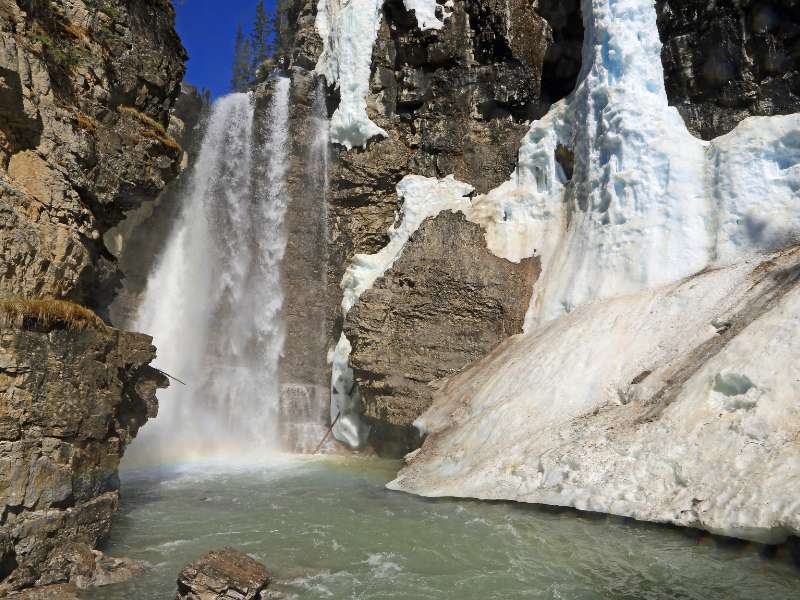
This trail continues where most hikers in winter stop – at the lower falls. Continue on to the upper falls for even more spectacular waterfalls and enjoy the thinned-out crowds.
- Trail Length: 5.1 km (return)
- Elevation Gain: 262 m
- Trail Difficulty: Easy
- Trail Type: Out and back
- Trailhead: Johnston Canyon Parking Lot on the Bow Valley Parkway
Continue Your Hike From the Johnston Canyon Upper Falls to the Ink Pots
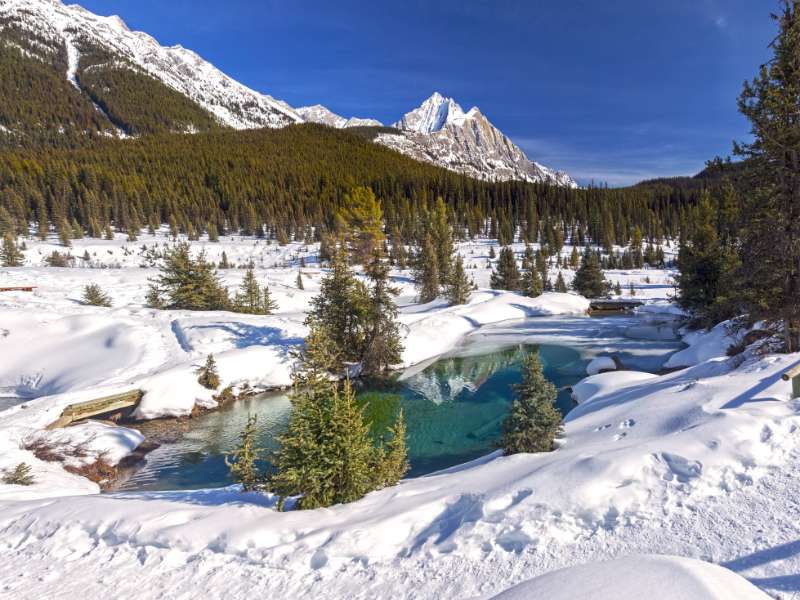
For a more adventurous winter hike, continue on to the spectacular Ink Pots. They’re five aquamarine pools formed by cold water springs with vibrant shades of blue and green from the minerals. The springs are ~4 C, so they never freeze, even in winter. The snow does get deeper here, though, so you may need snowshoes.
- Trail Length: 11.7 km (return)
- Elevation Gain: 608 m
- Trail Difficulty: Moderate to Challenging
- Trail Type: Out and back
- Trailhead: Johnston Canyon Parking Lot on the Bow Valley Parkway
More Winter Hikes in Banff National Park: Outside the Town Center
Hike to Sulphur Mountain
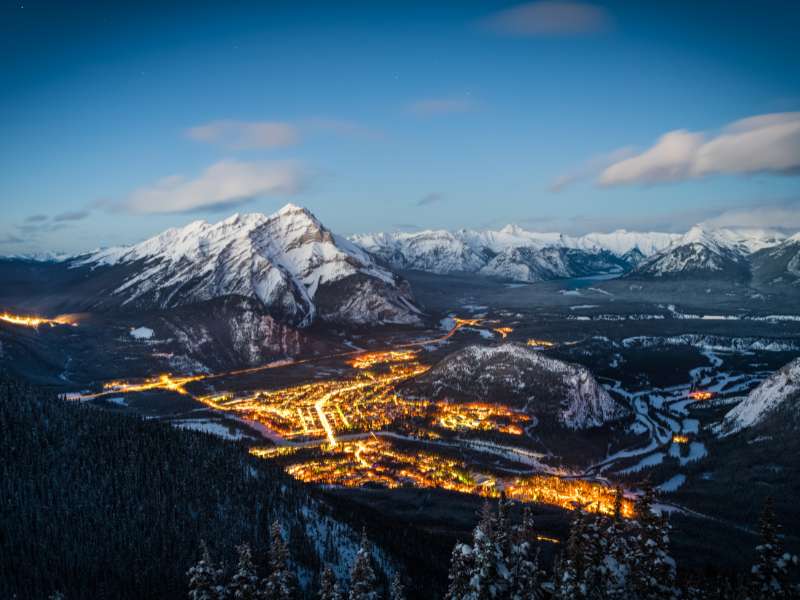
While most visitors whisk themselves up to Sulphur Mountain with the gondola, you can also hike up on a series of switchbacks. The gondola access means there are always people at the top, but it’s still worth it. It’s just not a winter hike that you do to get away from it all.
It’s steep in places and can be icy so bring your microspikes. Most of the hike is in the trees, but once you reach the summit ridge, you’re efforts are more than rewarded with breathtaking views over the Bow Valley and the Banff Town Center along an interpretive boardwalk. There will also be cheeky birds and squirrels begging you for food.
Insider Hiking Tip: As tempting as it may be, please don’t feed the wildlife. It’s illegal in national parks in Canada and comes with an expensive fine.
You can continue on a bit further to the Cosmic Ray Station, which was previously used to study cosmic rays and is now a National Historic Site of Canada, and get in a two-peak day with a short walk to the north end of Sulphur Mountain to Sanson Peak.
There’s also a restaurant and a cafeteria there to warm up. You can either return the same way or go down in the gondola for a different experience.
I highly recommend rewarding yourself for your efforts at the bottom with a visit to the nearby Banff Hot Springs. I always do this after hiking Sulphur Mountain. It’s a great way to warm up and it’s easy to see why a visit to the hot springs is one of the most popular Banff winter activities.
- Trail Length: 10.9 km
- Elevation Gain: 756 m
- Trail Difficulty: Moderate to Challenging
- Trail Type: Out and back
- Trailhead: Banff Gondola Parking Lot (~ 4km from Banff Town Center)
Hike on the Two Jack Lake Trail: To One of the Most Photographed Lakes in the Canadian Rockies
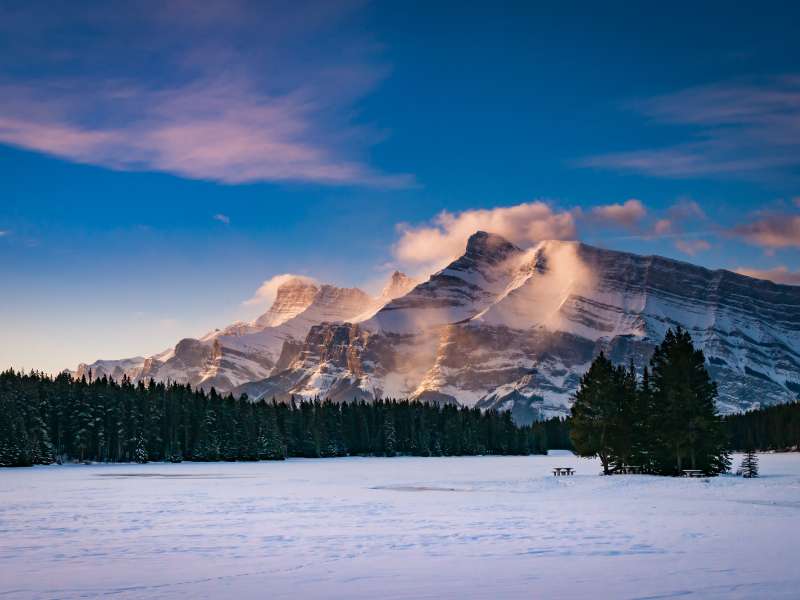
The trail along Two Jack Lake is admittedly more of a walk than a hike. In summer, it’s a very popular trail due to its proximity to Two Jack Lakeside Campground. However, in winter, it’s very quiet and peaceful.
Two Jack Lake is one of the most photographed lakes in the Canadian Rockies, with Mount Rundle in the backdrop for a truly beautiful view.
Insider Hiking Tip: Two Jack Lake is at its finest at sunrise or at sunset with the sun hitting Mount Rundle for an epic photo opp.
- Trail Length: 4.7km (roundtrip)
- Elevation Gain: 303 m
- Trail Difficulty: Easy
- Trail Type: Out and back
- Trailhead: Two Jack Lake Parking Lot
Hikes Around Mount Norquay
Hike to Upper Stoney Lookout
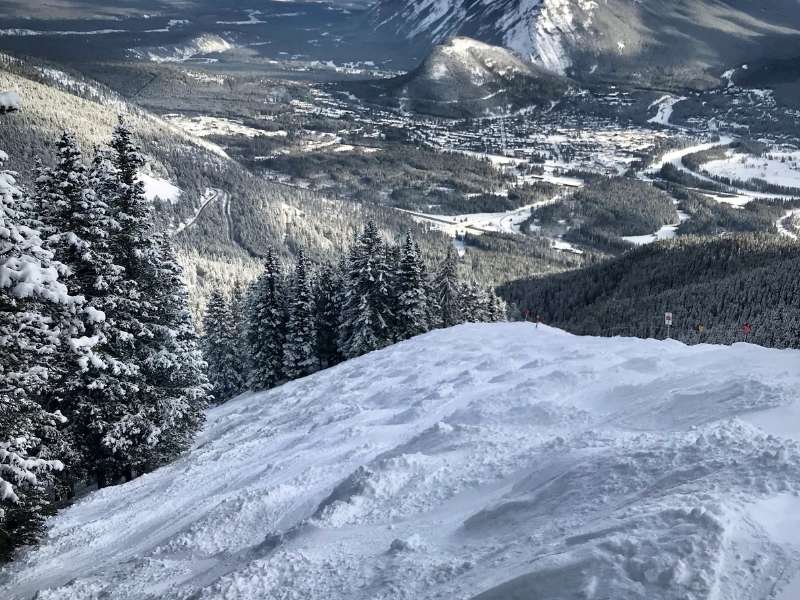
Your hike starts from Norquay Lodge and winds through dense forest as the trail climbs up until you reach the Upper Stoney Lookout (1868 m). From here you get an amazing view 500m above the Banff Town Center and of nearby Cascade Mountain.
Once you’ve soaked in the views, you’ll continue the loop, marked by a ribbon on the left of the trail, down the northern side of the mountain until you reach Norquay Lodge, where you can warm up over a meal or a hot chocolate.
Insider Hiking Tip: The road to reach the starting point may be closed due to weather conditions so check before you go. Also, you should only consider this hike if you have winter driving experience and winter tires on your car. See the link in the “Tips Section” below.
- Trail Length: 4.3 km (return)
- Elevation Gain: 239 m
- Trail Difficulty: Easy
- Trail Type: Loop
- Trailhead: Mount Norquay Ski Resort parking Lot
Winter Hikes from Banff Town Center
Hike to Tunnel Mountain
TheTunnel Mountain Trail offers a fantastic view of the Banff National Park and surrounding areas. This is one of the most popular hikes in the park because of its mostly gentle slopes with a few mildly steep sections.
This is the easiest mountain you can hike in winter and still say you’ve climbed a mountain. The hike starts off as a series of switchbacks up the Tunnel Mountain Trail, but never too steep.
As you near the summit, you’re rewarded with beautiful views over the Bow Valley and Vermilion Lakes. Just a bit further, and you’ll be looking down on the famed Banff Springs Hotel.
As if that’s not enough, Mount Rundle will feel like it’s within reaching distance. And you’ll get gorgeous views of Sulphur Mountain and Cascade Mountain across the valley.
- Trail Length:4.5 km (return)
- Elevation Gain: 267 m
- Trail Difficulty: Easy
- Trail Type: Out and back
- Trailhead: Tunnel Mountain Trailhead on St. Julien Road
Hike to Hoodoos Viewpoint
The Surprise Corner to Hoodoo Spire trail offers breathtaking views of the surrounding Rocky Mountains and the Bow Valley. You can see Sulphur Mountain across the shores of the Bow River as 2 of the best hotels in Banff, the Rimrock Hotel and the world-famous Banff Springs Hotel.
This winter trail is a favorite of locals. I’ve done it several times when looking for a relatively easy hike and always enjoy seeing the strange-looking hoodoos.
It starts at Surprise Corner, where you’ll get one of the best views of Banff by climbing a short set of stairs to a platform opposite the parking lot. From there, you get a beautiful view of Sulphur Mountain and the Bow River. You’ll also see two of Banff’s finest hotels, the Rimrock Hotel and the castle-like Banff Springs Hotel, which has hosted royalty.
You’ll then return to the trailhead and hike along the Hoodoos Trail and the Bow River. After ~ an hour, you’ll reach the HooddosViewpoint.
The highlight of this trail is the Hoodoos – eroded rock formed into spire and tower shapes. They’re unique geographical formations that you definitely won’t want to miss. You can read more about hoodoos here.
Besides the hoodoos, you’ll also get spectacular views of the Bow Valley, Tunnel Mountain, and Mount Rundle.
- Trail Length: 9.6 km
- Elevation Gain: 355m
- Trail Difficulty: Moderate
- Trail Type: Out and back
- Trailhead: Surprise Corner, ~20-minute walk from Banff Town Center – above Bow Falls where Buffalo St and Tunnel Mountain Road meet. There’s parking for approximately 10 cars.
Hike to Bow Falls Viewpoint: The Easiest Winter Hike in Banff
This very easy hike on the Bow Valley Trail, with very minimal elevation gain, starts at the bottom of the pedestrian bridge in the Banff Town Center. It’s a popular winter trail, so it’s a good choice if you’re new to hiking in winter and don’t want solitude or are looking for an easy winter hike.
The trail ends at a viewing platform overlooking Bow Falls, which are quite impressive. While you can see the falls from different points in Banff, this view offers the most stunning perspective.
- Trail Length: 2.7 km (return)
- Elevation Gain: 66 m
- Trail Difficulty: Easy
- Trail Type: Out and back
- Trailhead: Bottom of the pedestrian bridge in Banff Town Center
Winter Hikes in Lake Louise
Walk on Lake Louise Lakeshore Trail: The Easiest Winter Hike in Lake Louise
This is the easiest winter hike you can do in Lake Louise due to its minimal elevation gain. Admittedly, it’s more of a walk than a hike. From the Fairmont Chateau Lake Louise, you’ll walk along the right side of the lake until you reach the end of the lake. It’s a popular trail, even in winter. You’ll have views of Mount Fairview across the lake and glacier views at the end of the lake.
You can also skate on the frozen lake in winter, which looks like a winter wonderland with the magical Fairmont Chateau as a backdrop.
- Trail Length: 4.7 km
- Elevation Gain: 101 m
- Trail Difficulty: Easy
- Trail Type: Out and back
- Trailhead: Fairmont Chateau Lake Louise, past Lake Louise Village
Winter Hike to Fairview Lookout Trail: Easiest Hike for the Best Views Over Lake Louise
Fairview Lookout is a short but steep path, so you’ll work up a sweat. Fortunately, your efforts are more than rewarded from the platform viewpoint. From here you get amazing an amazing view offer the frozen Lake Louise and the grandiose Fairmont Chateau, which looks like something out of a fairytale. You’ll also get incredible mountain and glacier views. Directly across from you are the Devil’s Thumb, The Big Beehive, and Mount St Piran.
It’s a very popular trail in summer, but in winter, much less so. I’ve done this hike and had it all to myself, while other times have run into 10 or so other hikers.
If you’re feeling really ambitious and have snowshoes with you, you can continue on to the peak Fairview Mountain (2744 m).
Insider Hiking Tip: Due to its steepness, bring microspikes that fit over your boots for better traction so you don’t slip.
- Trail Length: 2.4 km (roundtrip)
- Elevation Gain: 167 m
- Trail Difficulty: Easy to Moderate
- Trail Type: Out and back
- Trailhead: Lake Louise parking lot
Winter Hike to Marsh Loop Hike
The Marsh Loop Trail is located at the base of the Cave and Basin National Park, starting at the parking lot. The hike encompasses boardwalks, bridges, and some small sets of stairs.
There are also benches scattered throughout the area so you can enjoy the scenery while enjoying a cup of hot chocolate. Marsh Loop hike is an especially popular winter trail with families.
This trail is a short loop that is perfect for all ages. It is an excellent option to enjoy the Bow River and views of Bow Valley without being too strenuous. Since it lies in the heart of the Cave and Basin area, it’s easy to add another adventure to your winter itinerary after completing the Marsh Loop.
- Trail Length: 2.8 km (return)
- Elevation Gain: 102 m
- Trail Difficulty: Easy
- Trail Type: Loop
- Trailhead: Cave and Basin parking lot
Winter Hike to Fenland Trail
From the parking lot and trailhead, follow the flat trail through the woods. Soon after crossing a wooden bridge, you will arrive at a fork in the path. Take the left branch and follow the signs for the Fenland Loop.
Insider Tip: There are several entrances and exits along this route, so be careful to stay on track.
At the next junction, take the right fork and head towards the lake. The trail begins to narrow when you get to this point but you will also spot gorgeous views and benches to rest and take photos at. We were lucky to see Beavers and Muskrats in the creek when we passed by, so make sure you keep an eye out too!
At the next junction, take a right and continue along Echo Creek as the trail begins to narrow. There are various benches and viewpoints along this section that are great for taking a break and enjoying views. Look for Muskrats and Beavers in the creek; you’ll be lucky if you can spot one!
Continue along the Creekside Trail, admiring the views as the hike goes on. You will likely be hearing the highway when you come across a small junction with a footbridge. Cross the bridge and turn left onto Vermillion Lake Road.
Walk along the road for approximately 0.3 miles, then turn left onto the paved path again. The trail will take you back to the parking lot where you started.
- Trail Length: 1.8 km
- Elevation Gain: 55 m
- Trail Difficulty: Very easy
- Trail Type: Loop
- Trailhead: Just north of the Fenlands Banff Recreation Centre
Related Reading: Snowshoe in Whistler: The 9 Best Trails
Winter Hike Around Johnson Lake
From the parking lot, head toward the beautiful Johnson lake. There is a path that goes either left or right. The route that goes right passes the power pylons briefly and circles the lake in the trees. As you progress, you get better views of the lake.
Johnson Lake is a local favourite, one reason being that it is much more protected from wind than other lakes, such as the Vermillion Lakes. It’s a good choice for a winter hike on a windy day.
Coming to the end of the path, you’ll descend down a steep hill and then cross a small stream. There are usually people fishing in Johnson Lake nearby. After crossing the stream, you’ll be back on level ground again. The remainder of the trail offers you more snow-covered trees all the way back to the parking lot where you started.
Insider Banff Winter Tip: There is a confusing section near the end of the trail where there are several paths intersecting, so offline mapping is highly recommended.
The hike itself is fairly level, though there are a few minor ups and downs. It’s convenient to reach from downtown Banff and Lake Louise, making it perfect for day hikes, family outings, or group excursions.
Johnson Lake is one of the better spots in Banff to ice skate, another popular winter activity you can do in Banff. . The key to ideal ice skating conditions is to hit the lake after it has frozen completely, but before it gets covered with fresh snow. That way, the ice won’t get too thick and hard to skate on.
Insider Banff Winter Tip: Always check if it’s safe to ice skate. Check in advance at the park office.
- Trail Length: 3.2 km
- Elevation Difference: 74 m
- Trail Type: Loop
- Trailhead: End of Johnson Lake Road
Hike to Taylor Lake
Taylor Lake is a beautiful place to visit in the Canadian Rockies. There are several hiking trails nearby, including the Taylor Creek Trail, which takes you through the forested area surrounding the lake. The first part of the hike is relatively flat, which means you can walk briskly along the path.
From the parking lot, take the trail to your right indicating Taylor Lake Trail. The hike begins with a gradual ascent As you gain elevation, you’ll cross several small footbridges over the creek.
After the second bridge, you will arrive at a meadow which can be very wet in spring.
Finally, you’ll arrive at Taylor Lake with Mount Bell as a backdrop.
Insider Banff Winter Tip: Depending on when you do this, you may need snowshoes.
- Trail Length: 13.7km
- Elevation Difference: 907 m
- Trail Type: Out and back
- Trailhead: Taylor Lake parking lot that’s found along the TransCanada Highway 1 between Lake Louise and the exit to Highway 93
7 Tips for Winter Hiking in Banff
- Always check the latest trail conditions before you start your hike. Roads or trails may be closed because of seasonal hazards such as avalanche risk, icy conditions, or falling icicles.
- Consider taking an avalanche awareness or training course to assess avalanche risk. If you’re an occasional winter hiker, you can get away with asking the staff at the park office about the avalanche risk of the hike you want to do, but if you regularly hike in winter, it’s definitely worth learning how to read avalanche terrain and the probability of an avalanche – especially if you plan to hike in remote areas, or areas where there aren’t staff to ask.
- Don’t let winter travel scare you off, but do take some extra precautions. You should have experience with winter driving and have winter tires on your car. If you don’t, you’ll want to assess the conditions carefully before heading out. Even if the roads are clear in Calgary, there’s always more snow in Banff, so check the road conditions. And while Highway 1 from Calgary to Banff may be clear, secondary roads will likely be less so, so if you’re uncertain, choose a hike that starts in or near Banff Town Center.
- Ensure you have the proper winter hiking gear. You’ll find more details in our winter hiking gear post. But of special note is a pair of microspikes that fit over your boots, extra layers, in case you get wet or cold. Depending on how cold it is, you’ll like want to wear long underwear or even snow pants. If you’re hiking with kids, you’ll definitely want to dress them in snow pants.
- Use hiking poles when hiking in winter to help prevent you from slipping. While not everyone likes hiking with poles, I think they’re essential in winter. These provide extra traction and keep you from slipping, and are especially useful when descending.
- If you’re new to winter hiking, start with a short hike, the progress from there. Even if you’ve done a lot of hiking in summer but are new to hiking in winter, start with a short hike. Not only is it more difficult due to the ice, snow and cold, but you’ll also want to see how your gear holds up, whether you’re cold and need to bring an extra layer next time, etc. You don’t want to find out 2 hours into a hike that your hands are freezing and you don’t have any other gloves and still have to return the same way.
- Warm up in the Banff Hot Springs after your hike. I do this after almost every winter hike. It’s sooooo rewarding after a hike and gives you something to look forward to.
Add these Banff winter hikes to your winter bucket list and rediscover what nature has to offer at all times of the year. See you on the trails!
Be sure to check out the best hotels in Banff too.
